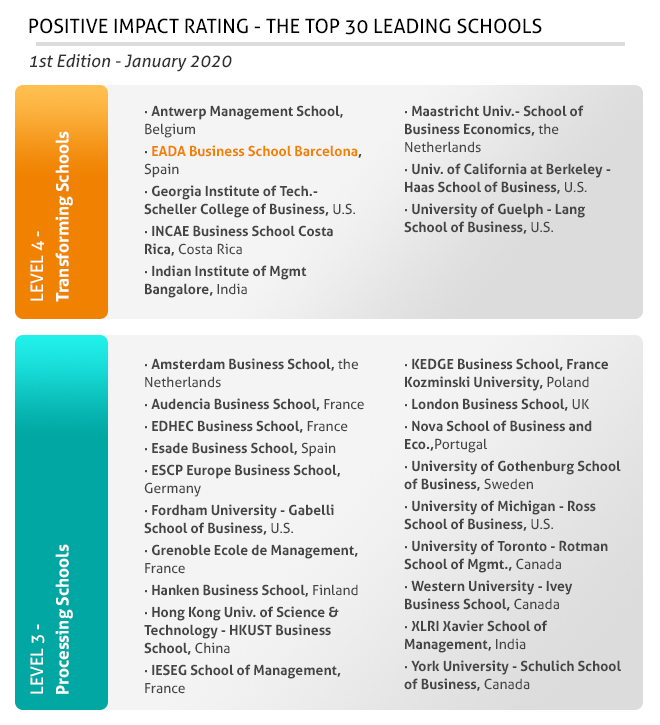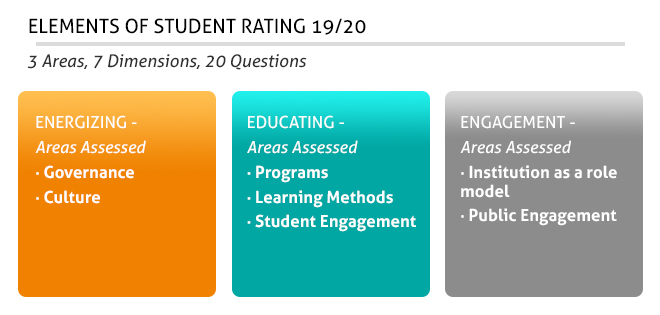EADA rated as one of the “best business schools for the world”
 EADA has achieved great international recognition after being rated among the top nine business schools for their positive impact in society. The results of the student-voted Positive Impact Rating (PIR), a new global evaluation led by the Positive Rating Association, based in Davos (Switzerland), which has the support of United Nations Global Compact, OXFAM International and WWF. This rating, which were published this morning in Davos, show the top 30 institutions which have performed well.
EADA has achieved great international recognition after being rated among the top nine business schools for their positive impact in society. The results of the student-voted Positive Impact Rating (PIR), a new global evaluation led by the Positive Rating Association, based in Davos (Switzerland), which has the support of United Nations Global Compact, OXFAM International and WWF. This rating, which were published this morning in Davos, show the top 30 institutions which have performed well.
Although none of the business schools achieved the top position of level 5, EADA Business School was chosen as one of the nine institutions to be included in the level 4 rating of “transforming schools”. These schools received a higher evaluation than the rest for their impact incorporated into the school’s culture (+18%) and governance (+23%), which are considered essential dimensions for a change impact process. The students also rated these schools highly for including sustainability and social commitment in their mission and for the degree in which these factors are considered the driving force behind the school.
Students highlighted two fundamental areas when evaluating EADA Business School: leadership development as the basis of all of its programmes and the strong EADA community which organises both academic and extracurricular activities related to social and environmental issues.
Jordi Pursals, President of the EADA Business School Foundation, is pleased not only due to the school’s prominent position in the ratng but also because “we are immersed in a paradigm shift with no way back in which capitalism needs to be sustainable and we have to be able to train its leaders.”
According to Jordi Díaz, Associate Dean of Programmes and International Relations, “when asked, our stakeholders tell us there are two special things about EADA. One is having leadership development as the backbone of all our programmes, and the second is the strength of the EADA community”. Díaz highlights that “across all programmes participants take part in successive, full-immersion, leadership development modules to help them define their purpose, and to implement this when leading themselves, leading teams and leading in society.” The classroom, however, is not the only learning space that helps them shape and develop that purpose. “Through the EADA community we also make sure that there are curricular and extracurricular experiences related to social and environmental issues, mixing different programmes and nationalities and engaging with external stakeholders. Working throughout the year as a close-knit diverse community has a multiplier effect: it enriches each individual’s views, challenges assumptions and generates accountability”.
In this first edition, the organisation selected students from the top 50 business schools in the world from the Financial Times Masters in Management 2018 (FT) ranking and the top 50 from the Corporate Knights Green MBA (CK) ranking. In total, 51 business schools took part in the evaluation process.

A change in criteria and the future
The traditional view of business schools is to train participants to develop their management skills and provide talent to companies. In this way, business schools support both the economy and business. To date, generating a positive impact for society has not been considered important. However, according to figures from the UN the demand for greater sustainable development has increased over the last decade.
The new PIR rating, which uses 20 questions to evaluate 3 areas and 7 dimensions, meets this demand and signals 2019 as a watershed year where young people have spoken out. The global conscience has shifted towards the climate emergency but also towards social justice and the aim of this rating is for it to become a lever for change. Ratings are becoming increasingly more important and the PIR offers a new and better way of evaluating business schools in the 21st century.
A school’s impact is measured in three areas (dynamism, training and commitment) which are then divided into seven dimensions (see table below) which includes the evaluation of the programmes on offer, the learning methods used and the active participation of the students. Two essential areas for the creation of a positive impact are evaluated: the school’s culture and governance. It also analyses the public engagement of the participants and whether the students consider the institution to be a role model.

